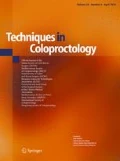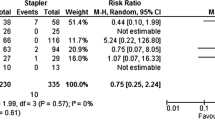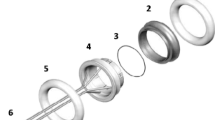Abstract
Anastomotic leaks are a feared complication of colorectal resections and novel techniques that have the potential to decrease them are still sought. This study aimed to compare the anastomotic leak rates in patients undergoing compression anastomoses versus hand-sewn or stapled anastomoses. Randomized controlled trials (RCTs) comparing outcomes of compression versus conventional (hand-sewn and stapled) colorectal anastomosis were collected from MEDLINE, Embase and the Cochrane Library. The quality of the RCTs and the potential risk of bias were assessed. Pooled odds ratios (OR) were calculated for categorical outcomes and weighted mean differences for continuous data. Ten RCTs were included, comprising 1969 patients (752 sutured, 225 stapled, and 992 compression anastomoses). Most used the biofragmentable anastomotic ring. There was no significant difference between the two groups in terms of anastomotic leak rates (OR 0.80, 95 % confidence interval (CI) 0.47, 1.37; p = 0.42), stricture (OR 0.54: 95 % CI 0.18, 1.64; p = 0.28) or mortality (OR 0.70; 95 % CI 0.39, 1.26; p = 0.24). Compression anastomosis was associated with an earlier return of bowel function: 1.02 (95 % CI 1.37, 0.66) days earlier (p < 0.001) and a shorter postoperative stay; 1.13 (95 % CI 1.52, 0.74) days shorter (p < 0.001), but significant heterogeneity among studies was observed. There was an increased risk of postoperative bowel obstruction in the compression group (OR 1.87; 95 % CI 1.07, 3.26; p = 0.03). There was no significant difference in wound-related and general complications, or length of surgery. Compression devices do not appear to provide an advantage over conventional techniques in fashioning colorectal anastomoses and are associated with an increased risk of bowel obstruction.










Similar content being viewed by others
References
Peeters KC, Tollenaar RA, Marijnen CA et al (2005) Risk factors for anastomotic failure after total mesorectal excision of rectal cancer. Br J Surg 92:211–216
Hyman N, Manchester TL, Osler T, Burns B, Cataldo PA (2007) Anastomotic leaks after intestinal anastomosis: it’s later than you think. Ann Surg 245:254–258
Slieker JC, Daams F, Mulder IM, Jeekel J, Lange JF (2013) Systematic review of the technique of colorectal anastomosis. JAMA Surg 148:190–201
Neutzling CB, Lustosa SA, Proenca IM, da Silva EM, Matos D (2012) Stapled versus handsewn methods for colorectal anastomosis surgery. Cochrane Database Syst Rev 2:CD003144
Ballantyne GH (1984) The experimental basis of intestinal suturing. Effect of surgical technique, inflammation, and infection on enteric wound healing. Dis Colon Rectum 27:61–71
Aggarwal R, Darzi A (2005) Compression anastomoses revisited. J Am Coll Surg 201:965–971
Kaidar-Person O, Rosenthal RJ, Wexner SD, Szomstein S, Person B (2008) Compression anastomosis: history and clinical considerations. Am J Surg 195:818–826
Zbar AP, Nir Y, Weizman A, Rabau M, Senagore A (2012) Compression anastomoses in colorectal surgery: a review. Tech Coloproctol 16:187–199
Corman ML, Prager ED, Hardy TG Jr, Bubrick MP (1989) Comparison of the Valtrac biofragmentable anastomosis ring with conventional suture and stapled anastomosis in colon surgery. Results of a prospective, randomized clinical trial. Dis Colon Rectum 32:183–187
Forde KA, McLarty AJ, Tsai J, Ghalili K, Delany HM (1993) Murphy’s Button revisited. Clinical experience with the biofragmentable anastomotic ring. Ann Surg 217:78–81
Massi G, Di Castro A, Brocato R, Adami EA, Biancari F (1997) Biofragmentable anastomosis ring in emergency surgery. Ann Chir Gynaecol 86:357–359
Buchberg BS, Masoomi H, Bergman H, Mills SD, Stamos MJ (2011) The use of a compression device as an alternative to hand-sewn and stapled colorectal anastomoses: Is three a crowd? J Gastroint Surg 15:304–310
Liberati A, Altman DG, Tetzlaff J et al (2009) The PRISMA statement for reporting systematic reviews and meta-analyses of studies that evaluate healthcare interventions: explanation and elaboration. BMJ 339:b2700
Higgings JPT, Sterne JAC (2011) Assessing risk of bias in included studies. In: Higgins JPT, Green, S. (ed) Cochrane handbook for systematic reviews of interventions version 5.1.0 (updated March 2011). The Cochrane Collaboration
Bubrick MP, Corman ML, Cahill CJ, Hardy TG Jr, Nance FC, Shatney CH (1991) Prospective, randomized trial of the biofragmentable anastomosis ring. The BAR Investigational Group. Am J Surg 161:136–142
Cahill CJ, Betzler M, Gruwez JA, Jeekel J, Patel JC, Zederfeldt B (1989) Sutureless large bowel anastomosis: European experience with the biofragmentable anastomosis ring. Br J Surg 76:344–347
Chen S, Yang B, He JH, Zhang YC, Lai DM (2009) Randomized trial on the application of biofragmentable anastomosis ring in intestinal anastomosis. Chin Med J 122:1755–1758
Dyess DL, Curreri PW, Ferrara JJ (1990) A new technique for sutureless intestinal anastomosis. A prospective, randomized, clinical trial. Am Surg 56:71–75
Galizia G, Lieto E, Castellano P et al (1999) Comparison between the biofragmentable anastomosis ring and stapled anastomoses in the extraperitoneal rectum: a prospective, randomized study. Int J Colorectal Dis 14:286–290
Gullichsen R, Havia T, Ovaska J, Rantala A (1992) Colonic anastomosis using the biofragmentable anastomotic ring and manual suture: a prospective, randomized study. Br J Surg 79:578–580
Pahlman L, Ejerblad S, Graf W et al (1997) Randomized trial of a biofragmentable bowel anastomosis ring in high-risk colonic resection. Br J Surg 84:1291–1294
Seow-Choen F, Eu KW (1994) Circular staplers versus the biofragmentable ring for colorectal anastomosis: a prospective randomized study. Br J Surg 81:1790–1791
Nudelman I, Fuko V, Waserberg N et al (2005) Colonic anastomosis performed with a memory-shaped device. Am J Surg 190:434–438
Murphy JB (1892) Cholecysto-intestinal, gastro-intestinal, entero-intestinal anastomosis, and approximation without sutures. Med Rec (NY) 42:665–676
Kanshin NN, Lytkin MI, Knysh VI, Klur V, Khamidov AI (1984) First experience with application of compression anastomoses with the apparatus AKA-2 in operations on the large intestine. Vestn Khir Im I I Grek 132:52–57
Hardy TG Jr, Pace WG, Maney JW, Katz AR, Kaganov AL (1985) A biofragmentable ring for sutureless bowel anastomosis. An experimental study. Dis Colon Rectum 28:484–490
Nudelman IL, Fuko VV, Morgenstern S, Giler S, Lelcuk S (2000) Gastrointestinal anastomosis with the nickel-titanium double ring. World J Surg 24:874–877
Nudelman I, Fuko V, Rubin M, Lelcuk S (2004) A nickel-titanium memory-shape device for colonic anastomosis in laparoscopic surgery. Surg Endosc 18:1085–1089
Nudelman IL, Fuko V, Greif F, Lelcuk S (2002) Colonic anastomosis with the nickel–titanium temperature-dependent memory-shape device. Am J Surg 183:697–701
Masoomi H, Luo R, Mills S, Carmichael JC, Senagore AJ, Stamos MJ (2013) Compression anastomosis ring device in colorectal anastomosis: a review of 1180 patients. Am J Surg 205:447–451
Tulchinsky H, Kashtan H, Rabau M, Wasserberg N (2010) Evaluation of the NiTi shape memory BioDynamix ColonRing in colorectal anastomosis: first in human multi-center study. Int J Colorectal Dis 25:1453–1458
Thompson SK, Chang EY, Jobe BA (2006) Clinical review: healing in gastrointestinal anastomoses, part I. Microsurgery 26:131–136
Bundy CA, Jacobs DM, Zera RT, Bubrick MP (1993) Comparison of bursting pressure of sutured, stapled and BAR anastomoses. Int J Colorectal Dis 8:1–3
Rullier E, Laurent C, Garrelon JL, Michel P, Saric J, Parneix M (1998) Risk factors for anastomotic leakage after resection of rectal cancer. Br J Surg 85:355–358
Thiede A, Geiger D, Dietz UA et al (1998) Overview on compression anastomoses: biofragmentable anastomosis ring multicenter prospective trial of 1666 anastomoses. World J Surg 22:78–86; discussion 87
Ghitulescu GA, Morin N, Jetty P, Belliveau P (2003) Revisiting the biofragmentable anastomotic ring: Is it safe in colonic surgery? Can J Surg 46:92–98
Author information
Authors and Affiliations
Corresponding author
Ethics declarations
Conflict of interest
The authors declare that they have no conflict of interest
Ethical approval
The present paper as a review of the literature was exempt from approval.
Informed consent
For this review of literature informed consent was not required.
Rights and permissions
About this article
Cite this article
Slesser, A.A.P., Pellino, G., Shariq, O. et al. Compression versus hand-sewn and stapled anastomosis in colorectal surgery: a systematic review and meta-analysis of randomized controlled trials. Tech Coloproctol 20, 667–676 (2016). https://doi.org/10.1007/s10151-016-1521-8
Received:
Accepted:
Published:
Issue Date:
DOI: https://doi.org/10.1007/s10151-016-1521-8




